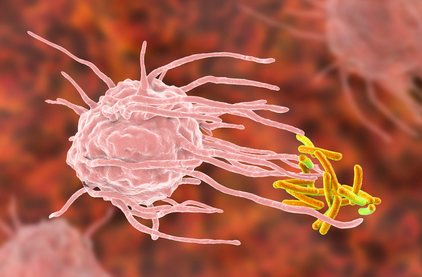Your immune system is your body’s own heroic defender, sending troops (immune cells) to the frontline to find and neutralize anything that threatens your body’s integrity. But do you know how it works?
A Quick Guide to the Immune System
Your immune system is your body’s own heroic defender, sending troops (immune cells) to the frontline to find and neutralize anything that threatens your body’s integrity.
Your immune system uses complex, warlike tactics to keep you safe from these threats. Just as the military uses artillery and infantry together with aerial support, your immune system combines multiple brigades of specialized cells that work together to keep you healthy.
One branch of your immune army is the Innate Immunity brigade.

A macrophage reaches out to engulf invading bacteria.
The immune cells in the Innate Immunity brigade respond to anything in your body that shouldn’t be there, from your own damaged cells to bits of dirt to germs. This brigade deploys special cells called “macrophages” - which translates as “big eaters” — to go out and, well, literally eat these foreign materials.
Macrophages don’t care what they come across; if it shouldn’t be in your body, they’re gonna eat it. These are the foot soldiers of your immune system.
The other branch of your immune army is the Adaptive Immunity brigade.

The smaller T cell attacks a larger tumor cell.
The Adaptive Immunity brigade are the Special Forces of the immune system. They train hard to recognize individual threats and learn how to take them out.
First, the adaptive immunity brigade sends out the B Cell battalion. B cells are specialized cells that memorize the features of a specific threat, whether it’s your own cells that have gone haywire or germs from the external environment. B cells then produce individualized molecular flags called “antibodies” which are customized for each distinct threat. The antibodies tag the threat so other immune cells know it is harmful.
Next comes the T Cell battalion. Different platoons of T cells have different tasks; but one important unit is the Killer T Cells (more formally, cytotoxic T cells) whose job is to search out and destroy anything tagged with antibodies. These guys are the field artillery—they literally blow holes in cells that are flagged for destruction.

Antibodies consist of complex, tightly-wound proteins shaped like a “Y”.
Like the military, our immune system uses these multiple combat arms to provide overlapping layers of defense.
The innate immune system with its battalions of macrophages is non-specialized and forms the first line of defense. It responds to anything it finds that isn’t part of a healthy body, whether or not it’s seen it before. Because it’s non-specific, it is always at the ready to leap into action when needed.
The adaptive immune system with its battalions of B cells and T cells provides additional layers of defense. Since this brigade is highly specialized, it doesn’t kick into gear till it’s properly trained. B cells study and memorize the features of foreign or harmful entities found in your body, then create antibodies to target artillery fire on them. Killer T cells respond by training their sights on cells flagged with antibodies, then blow them up using specialized molecular machinery. These waves of troops take longer to reach the battlefield, but once they arrive they target the threat with deadly accuracy.
Amazingly, all these intricate defense operations take place in the healthy human body without our even having to think about it. Our cellular immune warriors are on the alert all day and all night, every day of our lives.
Now that we know about them, let’s all take a moment to thank a T cell!
Our next installment in this series covers what can go wrong when your immune system works too hard.
Please note: The above is a highly simplified overview of immune function and describes only one of several interrelated functions for B cells and T cells. For a deeper understanding, we suggest B Cells (B Lymphocytes) - The Definitive Guide | Biology Dictionary and T Cells - The Definitive Guide | Biology Dictionary.
-------------------------------------------------------------------------------------------------------------------
If you find our content useful, we’d appreciate your sharing it on your social media feeds. We’re a small family company with limited advertising dollars, so every bit of extra exposure helps! Also, if you have any questions or comments, please post them below and we’ll respond as quickly as we can!
GLOSSARY
Adaptive immunity https://www.thefreedictionary.com/adaptive+immune+system
Antibody https://www.thefreedictionary.com/antibody
B cell https://www.thefreedictionary.com/B+cell
Immune system https://www.thefreedictionary.com/Immune+system
Innate immunity https://www.thefreedictionary.com/innate+immune+system
Macrophage https://www.thefreedictionary.com/macrophage

